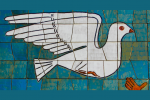March 23, 2021
My Navajo Prayer Life

Laughter, games, art activities, punch in little dixie cups, and cookies with cream fillings are what I remember most about Vacation Bible School (VBS) on the Navajo Nation. Churches came in droves to visit and minister to the children and families. It was the place to be for Elementary and Middle School kids. We loved to see all the smiling and welcoming faces of new people from the big cities willing to play with us and read, sometimes ready to teach some kids how to play the piano or the ukulele. The partners all loved to sing bible songs - so loud it seemed the windows would burst.
I was a baptized Episcopalian but VBS and Holidays were mostly the only times I went to church as a child. My parents and most of my relatives in my community follow the ways of Navajo teachings, ceremonies, and prayer. My mother was devout about prayer. Each morning, before the sun began to light up the horizon, she would start her daily prayers.
We lived in a traditional 2-bedroom home that my father built and heated our house with a potbelly wood and coal stove. Just over the mountain from where we lived was a coal mine that employed most families in my little community, including my father.
My mother would wake before the sun began to light up the horizon. She would rekindle the red embers in the stove to warm up our home. After her first cup of fresh coffee, she would take her leather pouch containing corn pollen, a sweet-tasting, yellow-colored powder collected from the tassels of mature corn plants used for prayer to symbolize life, out into the brisk, still dark morning. Facing the east direction, she began her prayers; now, I see them as prayers of adoration, confession, thanksgiving, and supplication (ACTS). Her prayer practice was lengthy and full of emotion. It spanned every person she thought of and every deed she felt needed prayer, all done in our language. As Navajo people, we think words have more meaning in Navajo than English because our words are descriptive and can contain emotion.
Prayer is powerful. In most indigenous cultures, prayer involves all life and creation. We pray for the earth that sustains all life, water that nourishes all living things, the fire that warms the home and keeps us safe, and the air that we breathe for life. Maintaining a connection to creation helps us be better stewards of the earth and reminds us that we are not the only living things.
A word we live by is Hozho. Hozho is such a small word with a significant meaning. It roughly translates to balance, peace, and harmony; these things are difficult to obtain and maintain in one's life. Morning prayer practice can be a way to live into Hozho, start your day new with positive thoughts and clear your mind of things you do not want to take into a new day.
There are many instances in life where I left and came back to the church. After my mother's death, I started going to church regularly at the age of 12 until I moved away at 16. Then as a young adult, I began attending church once again with weekly bible studies.
During these Bible studies, we used the Disciple's Prayer Book from Indigenous Ministries' office as our guide. After reading the Gospel three times, we would reflect and respond to three questions.
1. What word(s), idea(s), or sentence(s) stand out for you in the Gospel of the day?
2. What is Jesus (the Gospel) saying to you?
3. What is Jesus (the Gospel) calling you to do?
At this time in my life, I was the only person in my early 20's that attended bible study. Everyone around the table was a Navajo elder in the church except for one other person in their early 30's. This reflective time to respond to the questions was educational. We have a younger generation and an older generation discussing the Gospel and how it parallels our lives or how the Gospel is relevant in our time. We have had so many engaging discussions, found answers to questions we never asked, and created strong bonds. The simple task of encouraging the younger people, saying my daughter or son in Navajo, and creating a safe space has been life-changing. This study's reflective moment allowed us to learn more about each other, the bible, and prayer. I am always thankful for this time and the people, some now gone.
The Disciple's prayer book is like my mother's prayers. It seemed she would inwardly and unknowingly ask herself those three questions and respond. Many acts and deeds tie our lives and memories to prayer and the bible. Let us be welcoming and encouraging to all around us. We can each learn and teach from our life experiences. After prayers, we end with the Navajo words meaning peace has returned four times, four times for the four directions, four elements, four stages of life, and other representations.
Hózhó náhásdlíí'
Hózhó náhásdlíí'
Hózhó náhásdlíí'
Hózhó náhásdlíí'





